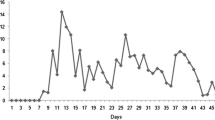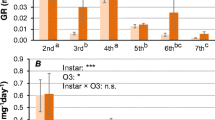Abstract
The buckeye butterfly,Junonia coenia (Lepidoptera: Nymphalidae), specializes on plants that contain iridoid glycosides. To determine the fate of these compounds in larvae, pupae, and adults of this species, we reared larvae on artificial diets with and without iridoid glycosides, and on leaves of a host plant,Plantago lanceolata (Plantaginaceae). Quantification by gas chromatography showed that newly molted third-, fourth-, and fifth-instar larvae reared on leaves ofP. lanceolata contained means of 5.13, 2.88, and 6.83% dry weight iridoid glycoside. In contrast, the mean iridoid glycoside concentration of actively feeding fifth-instar larvae was 0.28% dry weight, that of pupae was 0.19% dry weight iridoids, and adults contained no detectable iridoids. Feeding experiments suggested that this reduction in actively feeding larvae was due to the metabolism of iridoid glycosides.P. lanceolata leaves in these experiments contained a mean of 1.00% dry weight iridoid glycoside, with a 2:1 ratio of aucubin to catalpol. Calculation of iridoid consumption and utilization indices showed that larvae fed artificial diets consumed, digested, and sequestered aucubin and catalpol in similar ways. When these indices were calculated for larvae fed leaves ofP. lanceolata, catalpol was sequestered twice as efficiently as aucubin.
Similar content being viewed by others
References
Belofsky, G., Bowers, M.D., Janzen, S., andStermitz, F.. 1989. Iridoid glycosides ofAureolaria flava and their sequestration byEuphydryas phaeton butterflies.Phytochemistry 28:1601–1604.
Blum, M.S. 1981. The Chemical Defenses of Arthropods. Academic Press, New York.
Blum, M.S. 1983. Detoxication, deactivation, and utilization of plant compounds by insects, pp. 265–275, in P.A. Hedin (ed.). Plant Resistance to Insects. ACS Symposium Series 208. American Chemical Society, Washington, D.C.
Bobbitt, J.M., andSegebarth, K.P. 1969. Iridoid glycosides and similar substances, pp. 1–145,in W.I. Taylor and A.R. Battersby (eds.). Cyclopentanoid Terpene Derivatives. Marcel Dekker Inc., New York.
Boros, C.A., Stermitz, F.R., andMacFarland, N.. 1991. Processing of iridoid glycoside antirrinoside fromMaurandya antirrhiniflora (Scrophulariaceae) byMeris paradoxa (Geometridae) andLepipolis species (Noctuidae).J. Chem. Ecol. 17:1123–1133.
Bowers, M.D. 1980. Unpalatability as a defense strategy ofEuphydryas phaeton (Lepidoptera: Nymphalidae).Evolution 34:586–600.
Bowers, M.D. 1981. Unpalatability as a defense strategy of western checkerspot butterflies(Euphydryas, Nymphalidae).Evolution 35:367–375.
Bowers, M.D. 1984. Iridoid glycosides and host plant specificity in larvae of the buckeye butterfly,Junonia coenia (Nymphalidae).J. Chem. Ecol. 10:1567–1577.
Bowers, M.D. 1988a. Plant allelochemistry and mimicry, pp. 273–311,in P. Barbosa and D. Letourneau (eds.). Novel Aspects of Insect-Plant Interactions. John Wiley & Sons, New York.
Bowers, M.D. 1988b. Chemistry and coevolution: Iridoid glycosides, plants and herbivorous insects, pp. 133–165in K. Spencer (ed.). Chemical Mediation of Coevolution. Academic Press, Orlando, Florida.
Bowers, M.D. 1992. The evolution of unpalatability and the cost of chemical defense in insects,in M. Isman and B. Roitberg (eds.). Evolutionary aspects of insect chemical ecology. Chapman and Hall. In press.
Bowers, M.D., andFarley, S. 1990. The response of gray jays to palatable and unpalatable Lepidoptera.Anim. Behav. 39:699–705.
Bowers, M.D., andPuttick, G.M. 1986. The fate of ingested iridoid glycosides in lepidopteran herbivores.J. Chem. Ecol. 12:169–178.
Brattsten, L.B. 1979. Ecological significance of mixed-function oxidases.Drug Metab. Rev. 10:35–58.
Brattsten, L.B. 1986. Fate of ingested plant allelochemicals in herbivorous insects, pp. 211–255,in L.B. Brattsten and S. Ahmad (eds.). Molecular Aspects of Insect Plant Associations. Plenum Press, New York.
Brower, L.P. 1984. Chemical defense in butterflies, pp. 109–132,in R.I. Vane-Wright and P.R. Ackery (eds.). The Biology of Butterflies. Academic Press, London.
Brower, L.P., andBrower, J.V.Z. 1964. Birds, butterflies and plant poisons: A study in ecological chemistry.Zoologica 49:137–159.
Brower, L.P., andGlazier, S.C. 1975. Localization of heart poisons in the monarch butterfly.Science 188:19–25.
Brower, L.P., andMoffitt, C.M. 1974. Palatability dynamics of cardenolides in the monarch butterfly.Nature 249:280–283.
Cavin, J.C., andBradley, T.J. 1988. Adaptation to ingestion of (β-carboline alkaloids by heliconiini butterflies.J. Insect Physiol. 34:1071–1075.
Cohen, J.A. 1985. Differences and similarities in cardenolide contents of queen and monarch butterflies in Florida and their ecological and evolutionary consequences.J. Chem. Ecol. 11:85–103.
Cott, H.B. 1940. Adaptive Coloration in Animals. Methuen, London.
Duff, R.B., Bacon, J.S.D., Mundie, C.M., Farmer, V.C., Russell, J.D., andForrester, A.R. 1965. Catalpol and methyl catalpol: Naturally occurring glycosides inPlantago andBuddleia species.Biochem. J. 96:1–5.
Duffey, S.S. 1980. Sequestration of plant natural products by insects.Annu. Rev. Entomol. 25:447–477.
Edmunds, M. 1974. Defence in Animals: A Survey of Antipredator Defences. Longman, Harlow, Essex, England.
Erickson, J.M. 1973. The utilization of variousAsclepias species by larvae of the monarch butterfly,Danaus plexippus.Psyche 80:230–244.
Gardner, D.R., andStermitz, F.R. 1988. Host plant utilization and iridoid glycoside sequestration byEuphydryas anicia (Lepidoptera: Nymphalidae).J. Chem. Ecol. 14:2147–2168.
Haunerland, N.H., andBowers, W.S. 1986. Binding of insecticides to lepophorin and arylphorin, two hemolymph proteins of Heliothis zea.Arch. Insect Biochem. Physiol. 3:87–96.
Jarvi, T., Sillen-Tullberg, B., andWiklund, C. 1981. The cost of being aposematic: An experimental study of predation on larvae ofPapilio machaon by the great titParus major.Oikos 36:267–272.
L'Empereur, K.M., andStermitz, F.R. 1990. Iridoid glycoside content ofEuphydryas anicia (Lepidoptera: Nymphalidae) and its major host plant,Besseya plantaginea (Scrophulariaceae), at a high plains Colorado site.J. Chem. Ecol. 16:187–197.
Nishida, R., andH. Fukami. 1989. Host plant iridoid-based chemical defense of an aphid,Acyrthosiphon nipponicus, against ladybird beetles.J. Chem. Ecol. 15:1837–1843.
Nishio, S. 1980. The fates and adaptive significance of cardenolides sequestered by larvae ofDanaus plexippus (L.) andCycnia inopinatus (Hy. Edwards). PhD thesis, University of Georgia, Athens, Georgia, University Microfilms.
Papageorgis, C. 1975. Mimicry in neotropical butterflies.Am. Sci. 63:522–531.
Pereyra, P.C., andBowers, M.D. 1988. Iridoid glycosides as oviposition stimulants for the buckeye butterfly,Junonia coenia (Nymphalidae)J. Chem. Ecol. 14:917–928.
Rimpler, H. 1991. Sequestration of iridoids by insects, pp. 314–330,in J.B. Harborne and F.A. Thomas-Barberan (eds.). Annual Proceedings of the Phytochemical Society of Europe: Ecological Chemistry and Biochemistry of Plant Terpenoids. Oxford University Press.
Roeske, C.N., Seiber, J.S., Brower, L.P., andMoffitt, C.M. 1976. Milkweed cardenolides and their comparative processing by monarch butterflies (Danaus plexippus).Recent Adv. Phytochem. 10:93–167.
Rowell-Rahier, M., andPasteels, J.M. 1986. Economics of chemical defense in Chrysomelinae.J. Chem. Ecol. 12:1189–1203.
Scott, J.A. 1986. The Butterflies of North America. Stanford University Press, Stanford, California.
Scudder, G.G.E., Moore, L.V., andIsman, M.B. 1986. Sequestration of cardenolides inOncopeltus fasciatus: Morphological and physiological adaptations.J. Chem. Ecol. 12:1171–1187.
Seiber, J.N., Tuskes, P.M., Brower, L.P., andNelson, C.J. 1980. Pharmacodynamics of some individual milkweed cardenolides fed to the larvae of the monarch butterfly (Danaus plexippus).J. Chem. Ecol. 6:321–399.
Sillen-Tullberg, B. 1988. Evolution of gregariousness in aposematic butterfly larvae: A phylogenetic analysis.Evolution 42:293–305.
Sillen-Tullberg, B., andLeimar, O. 1988. The evolution of gregariousness in distasteful insects as a defense against predators.Am. Nat. 132:723–734.
Spencer, K.C. 1987. Specificity of action of allelochemicals: Diversification of glycosides, pp. 275–288,in G.R. Waller (ed.). Allelochemicals: Role in agriculture and forestry. ACS Symposium Series 330. American Chemical Society, Washington, D.C.
Stermitz, F.R., Gardner, D.R., Odendaal, F.J., andEhrlich, P.R. 1986.Euphydryas anicia utilization of iridoid glycosides fromCastilleja andBesseya (Scrophulariaceae).J. Chem. Ecol. 12:1456–1468.
Waldbauer, G.P. 1968. The consumption and utilization of food by insects.Adv. Insect Physiol. 5:229–288.
Wilkinson, C.F. 1986. Xenobiotic conjugation in insects.Am. Chem. Soc. Symp. 299:48–61.
Wink, M. 1988. Carrier-mediated uptake of pyrrolizidine alkaloids in larvae of the aposematic and alkaloid-exploiting moth Creatonotos.Naturwissenschaften 75:524–525.
Author information
Authors and Affiliations
Rights and permissions
About this article
Cite this article
Bowers, M.D., Collinge, S.K. Fate of iridoid glycosides in different life stages of the Buckeye,Junonia coenia (Lepidoptera: Nymphalidae). J Chem Ecol 18, 817–831 (1992). https://doi.org/10.1007/BF00988322
Received:
Accepted:
Issue Date:
DOI: https://doi.org/10.1007/BF00988322




